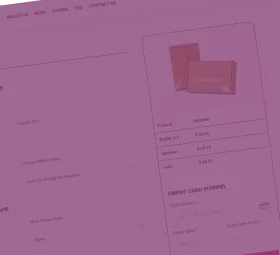Why Change Your Name After Divorce?
The decision to change your name after a divorce is deeply personal. Some people revert to their maiden name to symbolize a fresh start, while others may want to distance themselves from their ex-spouse.
Regardless of the reason, it’s important to understand the legal and administrative steps involved.
Make Your New Name Official Today!
Got your Divorce Decree? Our Name Change Kit helps you notify everyone of your name change, fast & stress free!
Step-by-Step Guide to Changing Your Name After Divorce
Step 1: Obtain Your Divorce Decree
Your final divorce decree is the key document in the name change process. This legal document, issued by the court, often includes a provision that allows you to revert to your maiden name or a previous name. If your decree doesn’t include this provision, you might need to petition the court for a name change by obtaining a court order.
Tip: If you’ve misplaced your divorce decree, you can obtain a certified copy from your state’s vital records office. The National Center for Health Statistics provides a state-by-state guide to help you find where to get this document.
Step 2: Gather Legal Proof of Your Former Name
You’ll need to establish a connection between your current name and your previous name. This step can be simplified if your divorce decree explicitly states your name change.
However, having additional proof, like your birth certificate or an old passport, can be beneficial.
Step 3: Update Your Name with the Social Security Administration (SSA)
Once you have your divorce decree, the next step is to update your name with the SSA. Complete Form SS-5, which is the application for a Social Security card. You can submit this form in person at your local Social Security office or by mail. Along with the form, you’ll need:
- Your divorce decree (original or certified copy)
- Proof of identity (e.g., passport, driver’s license)
- Proof of citizenship (e.g., birth certificate)
- Your current Social Security card
Tip: Visiting the SSA office in person is recommended to avoid losing important documents in the mail.
Step 4: Get a New Driver’s License or State ID
After updating your Social Security records, visit your local Department of Motor Vehicles (DMV) to update your driver’s license or state ID. Bring the following documents:
- Your updated Social Security card
- Your divorce decree
- Proof of identity (e.g., current driver’s license)
- Proof of citizenship (e.g., birth certificate)
- Proof of residency (e.g., utility bills)
Tip: Many states now offer the option to obtain a REAL ID, which will be required for domestic air travel starting May 7, 2025. Check your state DMV’s website for specific requirements and appointment scheduling.
Step 5: Update Your Passport
Updating your passport is essential if you plan to travel internationally. The process varies depending on how recently your passport was issued:
- If issued more than 12 months ago, use Form DS-82.
- If issued less than 12 months ago, use Form DS-5504.
- If your passport has expired for more than five years or you’re applying for the first time, use Form DS-11.
Mail the completed form along with your current passport, a recent color photograph, your divorce decree, and the applicable fee to the address listed on the form. Processing typically takes 6-8 weeks, but expedited services are available for an additional fee.
Tip: Ensure your travel plans don’t conflict with the passport update. Your travel reservations must match the name on your passport.
Step 6: Update Your Trusted Traveler Programs
If you’re enrolled in programs like Global Entry or TSA PreCheck, you’ll need to update your name to match your new passport. Start with Global Entry, as the change will automatically update TSA PreCheck. Contact your nearest Global Entry Enrollment Center and bring your updated documents.
Step 7: Update Your Voter Registration Information
It’s important to update your voter registration to reflect your new name. Most states allow you to do this online through their official voter registration websites, or you can mail in a National Voter Registration Form.
Step 8: Update Your Name with the United States Postal Service (USPS)
If your divorce involves an address change, notify the USPS of your new name and address to ensure your mail is correctly forwarded. This can be done online using the USPS Change-of-Address.
Step 9: Notify Your Employer
With your updated photo ID, inform your HR department of your name change. This will ensure that your payroll information and employee benefits are updated.
Step 10: Update Your Financial Accounts
Your name change will need to be reflected across all your financial accounts, including bank accounts. Here’s how to approach each type:
- Banks: Visit a branch with your updated ID and divorce decree.
- Credit Cards: Try updating your name online or call customer service.
- Mortgage: Contact customer service for instructions.
- Investments: Call customer service and provide the necessary documents.
- Insurance: Notify your providers for auto, home, life, and other insurance.
Step 11: Update Remaining Accounts
Finally, review your automatic payments and subscriptions to update your name. This includes utilities, streaming services, cell phone accounts, loyalty programs, and email accounts.
Make Your New Name Official Today!
Got your Divorce Decree? Our Name Change Kit helps you notify everyone of your name change, fast & stress free!
Streamline the Process with a Personalized Name Change Kit
Changing your name can involve updating your information in over 20 places. To simplify this process, we offer a comprehensive name change package that includes all the necessary forms and step-by-step instructions. Our package covers federal and state documents and other applicable accounts, saving you time and reducing the hassle.
Why Use NameChange.Com?
- Convenience: All forms in one place
- Personalization: Tailored instructions based on your specific situation
- Support: Guidance from start to finish
How to Get Started
Choose the name change package that suits your needs. Our team is here to assist you through every step, ensuring a smooth and efficient name change process. Get started today!
Embrace Your New Chapter with Confidence
Changing your name after a divorce is a significant step towards building a new chapter in your life. By following this comprehensive guide or by using our name change package, you can navigate the process with confidence and ease. Remember, reclaiming your identity is a powerful way to embrace your future.
Make Your New Name Official Today!
Got your Divorce Decree? Our Name Change Kit helps you notify everyone of your name change, fast & stress free!
FAQs About Changing Your Name After Divorce
How long does the name change process typically take?
- The duration varies depending on the state and the specific steps involved, such as court processing times, updating government IDs, and notifying various institutions. Generally, it can take several weeks to a few months to complete the entire process.
Can I change my name to something completely new after my divorce?
- Yes, you can choose a completely new name, but this typically requires a more formal legal process, including a court petition, public notice, and sometimes a hearing.
Do I need to notify my ex-spouse about my name change?
- There is usually no legal requirement to inform your ex-spouse of your name change, but it might be courteous to do so, especially if you share children or have ongoing joint responsibilities.
What if my divorce decree doesn’t mention my name change?
- If your divorce decree does not include a name change order, you will need to file a separate petition with the court to legally change your name.
How much does it cost to change my name after a divorce?
- The cost can vary widely depending on court fees. The cost of obtaining new documents (e.g., passport, driver’s license) and any legal assistance can range from $100 to $500 or more.
Will changing my name after divorce affect my credit score?
- No, changing your name does not directly affect your credit score. However, you need to ensure all your creditors are notified to maintain consistent credit reporting.
How do I change my name on my professional licenses and certifications?
- Contact the relevant licensing boards or certification bodies to find out their specific requirements. This often involves submitting a copy of your divorce decree and updated identification.
Can I revert to my maiden name if I remarry in the future?
- Yes, you can revert to your maiden name or choose a new name upon remarrying. The process will typically be included as part of the marriage license application.
Do I need to update my name on my children’s records?
- While you don’t need to change your children’s names, you may need to update school records, medical records, and other documents where your name appears for consistency.
What if I live abroad—how do I change my name after a divorce?
- If you are a U.S. citizen living abroad, you will need to update your name with the U.S. embassy or consulate and local authorities in your country of residence. The process may vary based on local laws and requirements.






